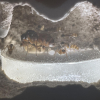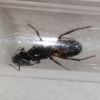So the other evening, I was in a local wooded area (northern New Jersey) and decided to explore some fallen, rotting trees. Looking under bark we found some termites, various beetles, pill bugs, fungi and then out of what seemed like the side of the wood, possibly underneath, to our surprise crawls a Camponotus queen (possibly chromaides or noveboracensis, not sure) , about 17mm in length. We captured her, and searched the log and ground to see if we could find any sign that she had anything going on (eggs, larvae, workers, etc) and didn’t find anything although working/lighting conditions were not ideal (actually we found one ant which turned out to be a Lasius queen, but that is not directly relevant).
I was hesitant to take her because of the timing of the year, but we did since she seemed by herself and I figured it was possible there is natural variation among these organisms that would relate to timing of nuptial flights, etc. She has been in a test tube set up. Because I was concerned, I figured I would offer some food, sugar water, which she readily accepted. I left her alone for a day or so, and checked again, and she has been pulling the cotton at the end of the test tube. Today I offered her a portion of a cricket, which once again, is readily accepted.
Is my venture here pointless? I work under the assumption that she would not accept food if she was just starting to found a new colony, and she would only take food if she had already had workers. Perhaps I missed something in the wood, and I have taken a queen that had already begun the process of founding? Does anyone have any opinion or advice?
Thanks in advance.



















